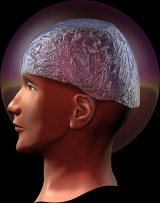Francis E. Dec was a New Yorker who had a relatively normal life as an Air Force radio operator, Bachelor of Arts graduate, and lawyer, until he was overtaken by paranoid schizophrenia and drew out the remainder of his years as a harmless crank who wrote a series of documents detailing a vast conspiracy-theory worldview which he mailed out and otherwise shared. We're talking racism, sexism, homophobia, religious conspiracies, mind-control rays, the works.
That bein' said so, his ravings make for a fun little theme park of kooky whimsy.
He's since achieved underground cult status, with tributes popping up everywhere from the Church of the Subgenius to Discordianism to popular music, including fictionalized versions of his works and a whole fan site, seen here.
So, a few terms to know if you want to study Francis' worldview:
The Brain-Bank Cities:
Cities existing on the far side of the moon we never see and which house your moon-brain (your real brain) of the Computer God. Primarily based on your lifelong Frankenstein Radio Controls, your moon-brain of the Computer God activates your Frankenstein threshold Brainwash Radio inculcating conformist propaganda. As such, these cities and the moon-brains housed in them are a vital part of the Gangster Computer God Worldwide Secret Containment Policy.
The Computer Brain Machines:
These secret machines are used by the Gangster Government for the purpose of filling out all of its paperwork, such as taxes, forms, bills, etc. The speed of these machines is 2000 words a minute and they actually do the work which is supposedly done by Government Employees.
Infrared Crusader Priests:
These troops, created by the Computer God, were several hundred years ago responsible for the conquering and degeneration of the Slovene People, as well as for the savage butchery and experimentation upon thousands of innocents in order to perfect the process of implanting Frankenstein Controls inside the human skull. The Crusader Priests wore black robes and armor, with night-vision plastic lenses built into their helmets. They also used weapons smeared with Poison Nerve Jelly and conducted mass-exterminations by burning vast fields dusted with inflammable poison nerve gas powder Prussic Acid. Their headquarters were specially designated, fortified monasteries. Their modern-day successors include both black-robed judges and black-robed priests.
Frankenstein Slavery:
The process during which one’s own body is remote-controlled by the Worldwide Mad Deadly Gangster Computer God. Frankenstein slavery is usually most prevalent at night, when you are unwittingly operated upon by the Computer God Sealed Robot-arm Operating Cabinet. Sodomy and rape, performed upon you by your tormentors, is an added bonus.
Rumors abound of archival on Ubuweb, but I'll be hanged in Tarnation if I can find them.











